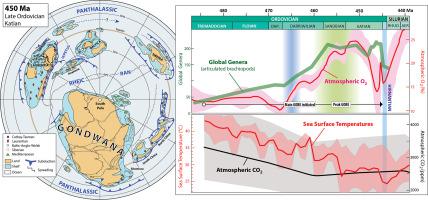当前位置:
X-MOL 学术
›
Gondwana Res.
›
论文详情
Our official English website, www.x-mol.net, welcomes your feedback! (Note: you will need to create a separate account there.)
Ordovician palaeogeography and climate change
Gondwana Research ( IF 6.1 ) Pub Date : 2020-10-01 , DOI: 10.1016/j.gr.2020.09.008 L. Robin M. Cocks , Trond H. Torsvik
Gondwana Research ( IF 6.1 ) Pub Date : 2020-10-01 , DOI: 10.1016/j.gr.2020.09.008 L. Robin M. Cocks , Trond H. Torsvik

|
Abstract New palaeogeographical reconstructions for the earlier Ordovician (480 Ma), and later Ordovician (450 Ma) integrate revised longitude-calibrated palaeomagnetic reconstructions and the inclusion of synthetic plate margins within the now-vanished oceanic areas. There are substantial published differences from the previous placing of some of the continents and terranes in Asia; for example, Siberia and Gondwana have previously been placed at varied distances and relative positions in relation to the Kazakh terranes, South and North China, and Tarim. But there are only minor changes for most of the world, particularly in the North American and European areas. The global distributions of benthic trilobites and brachiopods within faunal provinces and their changes through the Ordovician are plotted, including the new term Cathay-Tasman Province for some pan-equatorial brachiopod faunas from China and Australia, and key sites and provinces are shown on the revised maps. The 30 Myrs from 470 to 440 Ma (mid Ordovician to early Silurian) saw some of the most varied and changeable climates of the whole Phanerozoic culminating in the ‘Hirnantian’ ice age. Those changes in turn much affected the rates of evolution of many benthic and pelagic animal groups which were driven by both biological and environmental causes. Global cooling during the Ordovician was a prime factor by reducing sea surface temperatures which challenged life to evolve faster and more substantially than before. That cooling was driven by decreasing atmospheric CO2, for reasons that are not fully resolved, but probably included reduced sourcing (reduced continental arc activity) combined with increased silicate weathering due to the advent of land plants and perhaps the progressive exhumation of low-latitude collisional arcs. Since long-term CO2 sinks are largely controlled by palaeogeography, the general increase in the concentration of continents in the tropics during the Ordovician increased the overall global weathering.
更新日期:2020-10-01


























 京公网安备 11010802027423号
京公网安备 11010802027423号